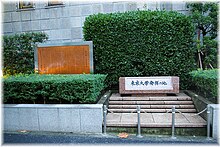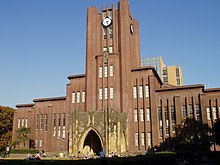University of Tokyo: Difference between revisions
→Ranking: Updating world university rankings for 2010, correcting material from 2009 |
Wikipedian05 (talk | contribs) deleting sentence per wikipedia policy on "academic boosterism" |
||
| Line 40: | Line 40: | ||
[[Image:Yasuda Auditorium, Tokyo University - Nov 2005.JPG|thumb|Yasuda Auditorium on the University of Tokyo's Hongō Campus.]] |
[[Image:Yasuda Auditorium, Tokyo University - Nov 2005.JPG|thumb|Yasuda Auditorium on the University of Tokyo's Hongō Campus.]] |
||
The {{nihongo|'''University of Tokyo'''|{{linktext|lang=jpn-Jpan|東京|大学}}|{{linktext|lang=jpn-Latn|Tōkyō|daigaku|lim=<nowiki> </nowiki>}}}}, abbreviated as {{nihongo|''Todai''|{{linktext|lang=jpn-Jpan|東大}}|{{linktext|lang=jpn-Latn|Tōdai}}}}<ref>[http://todai-yale.jp/whatis_todai.html What is Todai?]</ref>, is a major [[research university]] located in [[Tokyo]], [[Japan]]. The University has 10 [[faculty (university)|faculties]] with a total of around 30,000 students, 2,100 of whom are foreign. Its five campuses are in [[Hongō]], [[Komaba-Todaimae Station|Komaba]], [[Kashiwa]], [[Shirokanedai|Shirokane]] and [[Nakano, Tokyo|Nakano |
The {{nihongo|'''University of Tokyo'''|{{linktext|lang=jpn-Jpan|東京|大学}}|{{linktext|lang=jpn-Latn|Tōkyō|daigaku|lim=<nowiki> </nowiki>}}}}, abbreviated as {{nihongo|''Todai''|{{linktext|lang=jpn-Jpan|東大}}|{{linktext|lang=jpn-Latn|Tōdai}}}}<ref>[http://todai-yale.jp/whatis_todai.html What is Todai?]</ref>, is a major [[research university]] located in [[Tokyo]], [[Japan]]. The University has 10 [[faculty (university)|faculties]] with a total of around 30,000 students, 2,100 of whom are foreign. Its five campuses are in [[Hongō]], [[Komaba-Todaimae Station|Komaba]], [[Kashiwa]], [[Shirokanedai|Shirokane]] and [[Nakano, Tokyo|Nakano]]. |
||
==History== |
==History== |
||
Revision as of 07:04, 11 September 2010
This article needs additional citations for verification. (June 2007) |
35°42′48″N 139°45′44″E / 35.71333°N 139.76222°E
東京大学 | |
| File:U-tokyo logo.png | |
| Latin: Universitas Tociensis | |
| Type | Public (National) |
|---|---|
| Established | 1877 |
| President | Junichi Hamada (濱田純一) |
Academic staff | 2,429 full-time 175 part-time[1] |
| Students | 28,697[2] |
| Undergraduates | 14,274 |
| Postgraduates | 13,732 |
| 6,022 | |
Other students | 747 research students |
| Location | , , |
| Campus | Urban |
| Colors | Light Blue |
| Affiliations | IARU, APRU, AEARU, AGS, BESETOHA |
| Mascot | None |
| Website | u-tokyo.ac.jp |
| File:U-tokyo logotype.png | |



The University of Tokyo (東京大学, Tōkyō daigaku), abbreviated as Todai (東大, Tōdai)[3], is a major research university located in Tokyo, Japan. The University has 10 faculties with a total of around 30,000 students, 2,100 of whom are foreign. Its five campuses are in Hongō, Komaba, Kashiwa, Shirokane and Nakano.
History
The university was founded by the Meiji government in 1877 under its current name by amalgamating older government schools for medicine and Western learning. It was renamed "the Imperial University (帝國大學, Teikoku daigaku)" in 1886, and then Tokyo Imperial University (東京帝國大學, Tōkyō teikoku daigaku) in 1887 when the Imperial University system was created. In 1947, after Japan's defeat in World War II, it re-assumed its original name. With the start of the new university system in 1949, Todai swallowed up the former First Higher School (today's Komaba campus) and the former Tokyo Higher School, which henceforth assumed the duty of teaching first and second-year undergraduates, while the faculties on Hongo main campus took care of third and fourth-year students.
Although the university was founded during the Meiji period, it has earlier roots in the Astronomy Agency (天文方; 1684), Shoheizaka Study Office (昌平坂学問所; 1797), and the Western Books Translation Agency (蕃書和解御用; 1811).[4] These institutions were government offices established by the 徳川幕府 Tokugawa shogunate (1603–1867), and played an important role in the importation and translation of books from Europe.
Kikuchi Dairoku, an important figure in Japanese education, served as president of Tokyo Imperial University.
For the 1964 Summer Olympics, the university hosted the running portion of the modern pentathlon event.[5]
Organization
Faculties
- Law
- Medicine
- Engineering
- Letters
- Science
- Agriculture
- Economics
- Arts and Sciences
- Education
- Pharmaceutical Sciences
- History
- Environmental Studies
Graduate schools
- Humanities and Sociology
- Education
- Law and Politics
- Economics
- Arts and Sciences
- Science
- Engineering
- Agricultural and Life Sciences
- Medicine
- Pharmaceutical Sciences
- Mathematical Sciences
- Frontier Sciences
- Information Science and Technology
- Interdisciplinary Information Studies
- Public Policy
Research institutes
- Institute of Medical Science
- Earthquake Research Institute
- Institute of Oriental Culture
- Institute of Social Science
- Institute of Industrial Science
- Historiographical Institute
- Institute of Molecular and Cellular Biosciences
- Institute for Cosmic Ray Research
- Institute for Solid State Physics
- Ocean Research Institute
- Research Center for Advanced Science and Technology
Ranking
- Global University Ranking ranked the University of Tokyo 3rd in the world and 1st in Asia.[7]
- QS World University Rankings[8] in 2010 ranked the University of Tokyo 24th in the world, making it the second highest globally ranked university in Asia, after the University of Hong Kong, having been the highest in the 2009 THE-QS World University Rankings (in 2010 Times Higher Education World University Rankings and QS World University Rankings parted ways to produce separate rankings). In the 2010 QS Asian University Rankings, which employs a different methodology, Tokyo University came 5th, dropping from 3rd in 2009.[9]
- Academic Ranking of World Universities ranked the University of Tokyo 20th in the world and 1st in Asia.[10]
- Human Resources & Labor Review, a human competitiveness index & analysis published in Chasecareer Network, ranked the university 21st internationally and 1st in Asia for 2009.[11]
- École nationale supérieure des mines de Paris ranked the University of Tokyo 1st in the world on the basis of the number of alumni listed among CEOs in the 500 largest worldwide companies.[12]
- The university ranks 3rd in Japan in the number of alumni holding a post of executive in the listed companies of Japan.[13]
Notable alumni and faculty members
- University of Tokyo has produced many notable people. Fifteen prime ministers in Japan have studied at University of Tokyo.[14] Former prime minister Kiichi Miyazawa ordered Japanese government agencies to reduce the rate of employees who had attended the university's law faculty to below 50 percent due to concerns about diversity in the bureaucracy.[15]
- Six alumni of University of Tokyo have received the Nobel Prize.
- Yasunari Kawabata, Literature, 1968
- Leo Esaki, Physics, 1973
- Eisaku Satō, Peace, 1974
- Kenzaburō Ōe, Literature, 1994
- Masatoshi Koshiba, Physics, 2002
- Yoichiro Nambu, Physics, 2008
Campus
Hongo Campus
The main Hongo campus occupies the former estate of the Maeda family, Edo period feudal lords of Kaga Province. The university's best known landmark, Akamon (the Red Gate), is a relic of this era. The symbol of the university is the ginkgo leaf, from the trees found throughout the area.
-
Information Center
-
First Medical Building
-
Second Medical Building
-
Medical Experimental Research Bldg.
-
Medical Library
-
General Library
-
The Experimental Tank
Sanshiro Pond

Sanshiro Pond (三四郎池, Sanshirō ike), university's Hongo campus, dates to 1615. After the fall of the Osaka Castle, the shogun gave this pond and its surrounding garden to Maeda Toshitsune. With further development of the garden by Maeda Tsunanori, it became known as one of the most beautiful gardens in Edo (now Tokyo), with the traditional eight landscapes and eight borders, and known for originality in artificial pond, hills, and pavilions. It was at that time known as Ikutoku-en (Garden of Teaching Virtue). The pond's contours are in the shape of the character kokoro or shin (heart), and thus its official name is Ikutoku-en Shinjiike. It has been commonly called Sanshiro Pond after the title of Natsume Sōseki's novel Sanshiro.
Komaba Campus
One of the five campuses of the University of Tokyo, the Komaba Campus is home to the College of Arts and Sciences, the Graduate School of Arts and Sciences, the Graduate School of Mathematical Sciences, and a number of advanced research facilities and campus services. This is the campus where all the freshmen and sophomores of the University of Tokyo spend their college life. The University of Tokyo is the only university in Japan which has a system of two years of general education before students can choose and move on to special fields of study. The Komaba Campus is the cornerstone of general education, and was designated as the "center of excellence" for three new areas of research by the Ministry of Education and Science. There are currently over 7,000 students (freshmen and sophomores) enrolled in the general education courses, about 450 students (juniors and seniors) pursuing their specialties in the College of Arts and Sciences, and 1,400 graduate students in the advanced study.
Kashiwa Campus
This section needs expansion. You can help by adding to it. (January 2009) |
See also
- Gakushi-kai Alumni association
- Imperial College of Engineering
- Earthquake engineering
- Kikuchi Dairoku
- Koishikawa Botanical Gardens
- Koishikawa Annex, The University Museum, The University of Tokyo
- Nikko Botanical Garden
- The University of Tokyo Library
- International Journal of Asian Studies published in association with the Institute for Advanced Studies on Asia, University of Tokyo
References
- ^ "The University of Tokyo [Organization] Number of Students / Personnel". Retrieved 2007-06-14.
- ^ "東京大学 (学生数)学生・研究生・聴講生数". Retrieved 2007-06-14.
- ^ What is Todai?
- ^ 東大と天皇-大日本帝国の生と死 (Todai and Emperors - Life and Death of Imperial Japan), by 立花 隆(Takashi Tachibana), (pp 22-62), ISBN4-16-367440-3
- ^ 1964 Summer Olympics official report. Volume 2. Part 2. p. 761.
- ^ a b "Departments". The University of Tokyo.
- ^ "TOP - 100 (Global universities ranking)". Global Universities Ranking. 2009.
- ^ "QS World University Rankings 2010 Results".
- ^ "Asian university rankings - top 200". QS TopUniversities. 2010.
- ^ "Academic Ranking of World Universities - 2009". ShanghaiRanking Consultancy. 2009.
- ^ "300 Best World Universities 2010". ChaseCareer Network.
- ^ "International Professional Ranking of Higher Education Institutions". École nationale supérieure des mines de Paris. 2009.
- ^ "出身大学別上場企業役員数ランキング" (in Japanese). 大学ranking.net.
- ^ "大学別総理大臣リスト List of prime ministers by graduated universities" (in Japanese). 大学ranking.net.
- ^ McGregor, Richard (15 May 2010). "China's Private Party". Wall Street Journal.
External links
- University of Tokyo
- Kato, Mariko, "Todai still beckons nation's best, brightest but goals diversifying", Japan Times, August 11, 2009, p. 3.








